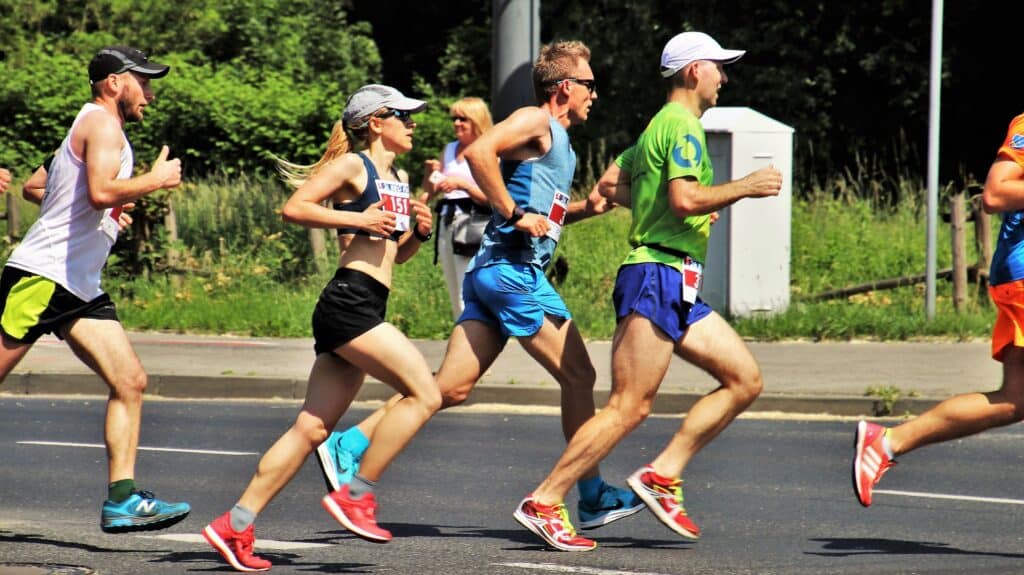Are you ready to lace up your running shoes and take on the challenge of completing your first 5K race? Whether you’re a complete beginner or looking to improve your running skills, this comprehensive guide will provide you with the knowledge and training for your first 5K run. We provide everything you need to achieve your goal. Let’s get started on this exciting journey!
Meet Sarah, a 32-year-old working professional who has always admired runners and wanted to give it a try herself. She loves the idea of participating in a 5K race, but the thought of training for it seems daunting. Sarah has never been much of a runner and is unsure of where to begin.
One day, while scrolling through her social media feed, Sarah comes across a post about training for a first 5K run. Intrigued, she starts doing some research and stumbles upon our comprehensive guide. It promises to provide all the information she needs to confidently train and prepare for her first race.
Inspired and motivated, Sarah dives into the guide, eager to learn everything she can about beginner 5K training. She discovers tips and techniques for goal setting, creating a training plan, selecting the right running gear, and improving her running form.
As Sarah progresses through the guide, she becomes more confident and committed to her training. She learns about the importance of building endurance, incorporating strength training, and fueling her body with proper nutrition. She also discovers strategies for overcoming mental barriers and preventing common running injuries.
With the knowledge and guidance from the guide, Sarah sets out on her training journey. She follows the recommended training schedule, completes her warm-up and cool-down exercises, and gradually increases her running distance. She discovers the thrill of pushing past her limits and the joy of seeing her progress.
The months go by, and race day finally arrives. Nervous but determined, Sarah lines up at the starting line alongside hundreds of other runners. She takes a deep breath, remembering the tips she learned about pacing, nutrition, and mental preparation.
As the starting horn blares, Sarah begins her first 5K race with newfound confidence. With every step, she feels the support of the running community around her. Crossing the finish line, Sarah is overcome with a sense of accomplishment and pride.
Training for her first 5K has not only transformed Sarah’s physical fitness but also her mindset. She has discovered a new passion and a belief in her own capabilities. As she reflects on her journey, Sarah is grateful for the comprehensive guide that made her dream of completing a 5K race a reality.
Key Takeaways:
- Setting clear and achievable goals is essential for training for your first 5K run.
- Creating a well-structured training plan will help you stay on track and make progress.
- Investing in the right running gear can enhance your comfort and performance.
- Warm-up and cool-down exercises are crucial for injury prevention and performance optimization.
- Building endurance gradually and incorporating strength training will improve your running abilities.
Setting Your Goals
When preparing for your first 5K run, one of the most important steps is setting your goals. Goal setting provides you with a clear target to work towards, giving your training purpose and direction. It helps you stay motivated and focused on your journey from start to finish.
To effectively set your goals, keep the following tips in mind:
- Be Realistic: Set achievable goals that align with your current fitness level. Start with smaller milestones and gradually increase the difficulty as you progress.
- Have a Specific Target: Define what you want to achieve with your 5K run. It could be completing the race within a certain time frame, running the entire distance without stopping, or simply crossing the finish line.
- Consider Your Timeline: Determine how much time you have to prepare for the race. This will help you set appropriate short-term and long-term goals that fit within your training schedule.
- Write it Down: Document your goals on paper or in a digital format. This adds accountability and serves as a constant reminder of what you’re working towards.
- Break it Down: Divide your goals into smaller, manageable steps. This allows you to track your progress and celebrate achievements along the way.
By setting realistic and achievable goals, you’ll have a clear roadmap for your training journey. Whether it’s completing your first 5K run or aiming for a personal best, having a target in mind will keep you motivated and focused on reaching your full potential.
Remember, every runner’s journey is unique, and your goals should be tailored to your individual needs and abilities. Embrace the process, stay committed to your goals, and enjoy the satisfaction of crossing that finish line on race day.
Setting goals is essential for your first 5K run. It provides direction, motivation, and a sense of accomplishment. Be realistic, specific, and break down your goals into manageable steps to stay focused on your journey towards success.
Creating Your Training Plan For Your First 5K
When preparing for your first 5K run, it’s essential to create a structured training plan. This will help you build endurance, improve your fitness level, and ultimately achieve your goal.
To create an effective training plan, consider the following:
Determine Your Training Schedule
Decide on the number of training days per week that work best for you. As a beginner, starting with three training days per week is recommended to allow for proper rest and recovery.
Gradually Increase Intensity
Avoid pushing yourself too hard too soon. Gradually increase the intensity of your workouts by incorporating a combination of running and walking intervals. This will gradually build your stamina and endurance over time.
Stick to a Structured Plan
Following a structured plan will ensure consistency and keep you on track. Set specific goals for each week, increasing your running time or distance gradually. Remember, slow and steady progress is key.
Include Rest Days
Don’t underestimate the importance of rest days. Your body needs time to recover and rebuild after intense workouts. Incorporate rest days into your training plan to avoid overtraining and reduce the risk of injuries.
Here’s an example of a beginner’s 5K training plan:
| Week | Training Days | Workout |
|---|---|---|
| 1 | 3 | Walk 5 minutes. Run 1 minute, walk 2 minutes (repeat 8 times). Walk 5 minutes |
| 2 | 3 | Walk 5 minutes. Run 2 minutes, walk 2 minutes (repeat 6 times). Walk 5 minutes |
| 3 | 3 | Walk 5 minutes. Run 3 minutes, walk 1 minute (repeat 6 times). Walk 5 minutes |
| 4 | 3 | Walk 5 minutes. Run 5 minutes, walk 1 minute (repeat 4 times). Walk 5 minutes |
| 5 | 3 | Walk 5 minutes. Run 8 minutes, walk 2 minutes (repeat 3 times). Walk 5 minutes |
| 6 | 3 | Walk 5 minutes. Run 12 minutes, walk 2 minutes (repeat 2 times). Walk 5 minutes |
| 7 | 3 | Walk 5 minutes. Run 20 minutes, walk 2 minutes (repeat 2 times). Walk 5 minutes |
| 8 | 3 | Walk 5 minutes. Run 30 minutes (non-stop). Walk 5 minutes |
Remember to listen to your body and adjust the plan if needed. Everyone progresses at a different pace, so tailor your training plan to your individual needs and abilities.

Essential Running Gear
When starting your running journey, it’s important to have the right gear to ensure a comfortable and enjoyable experience. Here are some essential running items that every beginner should consider:
1. Running Shoes
Investing in a good pair of running shoes is crucial for both comfort and injury prevention. Look for shoes with proper cushioning and support that are designed specifically for running. Take the time to get fitted at a specialty running store to find the perfect fit for your feet.
2. Moisture-Wicking Clothing
Wearing moisture-wicking clothing can help you stay dry and comfortable during your runs. Look for shirts, shorts, and socks made from breathable materials that can efficiently wick away sweat from your body. This will help prevent chafing and irritation, allowing you to focus on your run.
3. Sports Bra
For female runners, a supportive sports bra is essential to minimize discomfort and provide the necessary support. Look for a sports bra that offers proper compression and bounce control. A well-fitted sports bra can make a significant difference in your overall running experience.
4. Reflective Gear
If you plan to run outdoors, especially during low-light conditions, it’s important to wear reflective gear to ensure your visibility to others. Consider wearing a reflective vest or adding reflective strips to your clothing or shoes. Safety should always be a top priority when running outside.
5. Running Watch or Fitness Tracker
A running watch or fitness tracker can be a valuable tool to track your progress and keep you motivated. These devices can provide valuable insights into your pace, distance, heart rate, and other metrics, helping you understand how you’re improving over time.
6. Hat or Visor and Sunglasses
Protecting yourself from the sun is important during outdoor runs. Wearing a hat or visor can shield your face from the sun’s rays, while sunglasses can help protect your eyes and improve visibility. Choose lightweight and breathable options that won’t interfere with your comfort.
“Investing in the right running gear can significantly enhance your running experience and help you perform at your best. It’s important to prioritize comfort, safety, and functionality when choosing your gear.”
Remember, as a beginner, it’s not necessary to spend a fortune on expensive gear. Focus on finding items that fit well, promote comfort, and support your overall running journey. Gradually invest in additional gear as you progress and gain more experience.
Warm-Up and Cool-Down Exercises
Properly warming up and cooling down before and after your training sessions is essential for preventing injuries and optimizing your running performance. Incorporating dynamic stretches and mobility exercises into your routine can help prepare your muscles, joints, and cardiovascular system for the demands of running, as well as aid in the recovery process.
Here are some running techniques and examples of warm-up and cool-down exercises to include in your training:
Warm-Up Exercises
- Leg Swings: Stand facing a wall or support. Swing one leg forward and backward, then side to side, gradually increasing the range of motion. Repeat for each leg.
- High Knees: Stand tall and jog in place while lifting your knees as high as possible. Try to maintain a brisk pace and engage your core. Perform for 30 seconds to 1 minute.
- Butt Kicks: Jog in place while kicking your heels up towards your glutes. Focus on a quick turnover and landing softly. Perform for 30 seconds to 1 minute.
Cool-Down Exercises
- Quad Stretches: Stand tall and grab one ankle, pulling it towards your glutes until you feel a gentle stretch in the front of your thigh. Hold for 15-30 seconds on each side.
- Hamstring Stretches: Sit on the ground with one leg extended and the other bent with the sole of your foot against your inner thigh. Reach towards your extended foot, keeping your back straight. Hold for 15-30 seconds on each side.
- Standing Calf Stretches: Stand facing a wall or support, and place one foot behind you while keeping your heel on the ground. Lean forward, feeling the stretch in your calf. Hold for 15-30 seconds on each side.
Remember, warming up and cooling down are crucial components of your training routine. By incorporating these running techniques and exercises, you can reduce the risk of injury, improve flexibility, and enhance your overall running performance.

Building Endurance
Building endurance is a crucial aspect of preparing for your first 5K run. By gradually increasing your running distance and improving your cardiovascular fitness, you’ll be able to tackle the challenge with confidence. Here are some strategies and tips to help you build endurance and conquer your goals.
1. Follow a Couch to 5K Training Program
If you’re a beginner, a Couch to 5K program is an excellent way to start your training journey. This program is designed to gradually transition you from being a couch potato to a confident 5K runner. It typically consists of a mix of walking and running intervals, gradually increasing the running durations while reducing the walking time. This progressive approach allows your body to adapt to the demands of running and helps you build endurance safely.
2. Incorporate Interval Training
In addition to following a structured program, incorporating interval training sessions into your routine can be highly beneficial for building endurance. Interval training involves alternating between periods of high-intensity running and recovery periods of lower intensity or rest. This type of training challenges your cardiovascular system and helps improve your body’s ability to sustain longer efforts. For example, you can try alternating between 1-2 minutes of fast running with 2-3 minutes of slow jogging or walking. Gradually increase the duration of the intense intervals as you progress.
3. Increase Mileage Gradually
Gradually increasing your running mileage is key to building endurance and avoiding overuse injuries. It’s essential to listen to your body and not push yourself too hard too soon. Start by adding a small percentage, around 10-15%, to your weekly mileage. For example, if you’re currently running 10 miles per week, you can add an extra mile or two over the next week. Progressive overload is crucial to allow your body to adapt and become stronger gradually.
4. Incorporate Long Runs
Long runs are an integral part of endurance training. Once a week, set aside a designated day for a slightly longer run than what you’re used to. The long run helps condition your body to tolerate the demands of running for an extended period. Start with a distance that feels challenging but manageable, such as adding an extra mile or increasing your run duration by 10-15 minutes. Gradually increase the distance or time of your long runs as you progress through your training plan.
5. Practice Tempo Runs
Tempo runs, also known as threshold runs, are an excellent way to improve your running speed and endurance. These workouts involve maintaining a comfortably hard pace, slightly faster than your usual training pace, for an extended period. Start with a shorter tempo run, such as 10 minutes, and gradually increase the duration each week. Tempo runs push your lactate threshold, helping your body become more efficient at clearing lactate and sustaining a faster pace for longer periods.
6. Don’t Forget Recovery
Building endurance requires adequate rest and recovery. Allow your body time to adapt to the increased training load and replenish energy reserves. Incorporate rest days into your schedule and prioritize sleep and nutrition to support recovery. Listen to your body and be cautious of any signs of overtraining, such as excessive fatigue or persistent muscle soreness.
| Building Endurance | Strategies |
|---|---|
| Follow a Couch to 5K Program | Gradually transition from walking to running using structured intervals |
| Incorporate Interval Training | Alternate between high-intensity running and recovery periods |
| Increase Mileage Gradually | Add a small percentage to your weekly mileage to avoid overtraining |
| Incorporate Long Runs | Dedicate a day for slightly longer runs to condition your body |
| Practice Tempo Runs | Maintain a comfortably hard pace for extended periods to improve speed and endurance |
| Don’t Forget Recovery | Allow time for rest, sleep, and proper nutrition to support training adaptation |
Strength Training for 5K Runners
In addition to regular running workouts, incorporating strength training exercises into your routine can significantly enhance your running performance and help prevent common injuries. Here, we will explore a range of exercises specifically tailored to improve your running technique and boost overall strength.
Benefits of Strength Training for Runners
Strength training for runners offers numerous benefits. By targeting specific muscle groups, you can:
- Improve running form and efficiency
- Increase power and speed
- Enhance endurance
- Reduce the risk of injuries
Selecting the Right Exercises
When choosing exercises for your strength training routine, focus on movements that mimic running mechanics and engage the key muscle groups involved in running. Some effective exercises for runners include:
- Squats: Strengthen your quadriceps, hamstrings, and glutes, improving stability and power.
- Lunges: Work your quads, hamstrings, and glutes while also improving balance and stability.
- Single-leg stability exercises: Enhance balance and strengthen the muscles responsible for stability during running.
- Calf raises: Target your calf muscles, which play a crucial role in propulsion and shock absorption while running.
- Planks and core exercises: Strengthen your core muscles, enhancing stability and posture during running.
Remember to maintain proper form and start with lighter weights or bodyweight exercises if you’re a beginner. Gradually increase the resistance and intensity as you get stronger and more comfortable with the movements.
Strength Training Schedule
To maximize the benefits of your strength training, aim for at least two sessions per week, with a rest day in between to allow for muscle recovery. Incorporate these sessions into your overall training plan and ensure they complement your running workouts.
For a complete strength training routine specifically designed for runners, consult with a certified trainer or exercise physiologist who can create a personalized plan tailored to your individual needs and goals.

Proper Running Form
Having proper running form is essential for optimizing your performance and reducing the risk of injury. By maintaining proper posture, foot strike, arm movement, and breathing techniques, you can enhance your running efficiency. Here are some tips to help you improve your running form:
Posture
Keep your head up, eyes focused forward, and shoulders relaxed. Avoid slouching or hunching over as it can lead to inefficient breathing and strain on your back and neck.
Foot Strike
Strive for a midfoot strike to ensure even distribution of impact throughout your feet. Landing on your heel or forefoot can increase the risk of injuries such as shin splints or plantar fasciitis.
Arm Movement
Maintain a relaxed arm swing, keeping your elbows at approximately a 90-degree angle. Your arms should move in a forward and backward motion, not crossing your body. This helps with balance and propels your stride forward.
Breathing
Breathe deeply and rhythmically, syncing your breath with your running pace. Inhale through your nose and exhale through your mouth to maximize oxygen intake and release carbon dioxide efficiently.
“Proper running form is crucial for both performance and injury prevention. By focusing on your posture, foot strike, arm movement, and breathing, you can optimize your running technique and achieve your best results.” – Coach Jane Smith
In addition to these tips, it’s important to listen to your body and make adjustments as needed. Everyone’s body is different, so finding the running form that works best for you may require some trial and error. Remember to start slowly and gradually incorporate these techniques into your training routine.
Now that you understand the fundamentals of proper running form, you can take your training to the next level. In the next section, we will explore the role of nutrition in supporting your 5K training.
Nutrition for Runners
Proper nutrition plays a crucial role in supporting your training for a 5K run. Fueling your body with the right foods can enhance your performance, aid in recovery, and help you reach your running goals. Here are some key nutrition tips for beginners:
Pre-Run Meals
Before a training session or race, it’s important to consume a balanced meal that provides you with the necessary energy. Aim to eat a mix of carbohydrates, protein, and healthy fats. Carbohydrates are your body’s preferred source of fuel and can help sustain your energy levels during the run. Examples of pre-run meals include:
- Whole grain toast with peanut butter and banana
- Oatmeal topped with berries and nuts
- Yogurt with granola and fruit
Hydration
Staying hydrated is essential for optimal performance. Aim to drink water throughout the day and increase your fluid intake before, during, and after your run. Hydrate based on your individual needs and the duration of your run. It’s a good idea to carry a water bottle with you during your training sessions.
Post-Run Recovery
After your run, it’s important to replenish your body with the nutrients it needs to recover. Focus on consuming a combination of carbohydrates and protein within 30 minutes to an hour after your run. This can help replenish glycogen stores and aid in muscle repair. Some post-run snack ideas include:
- Chocolate milk
- Greek yogurt with a handful of nuts
- A protein smoothie with fruit and spinach
Remember to listen to your body’s hunger and fullness cues and adjust your portion sizes accordingly. It’s also a good idea to consult with a registered dietitian or nutritionist to ensure you’re meeting your individual nutritional needs as a runner.
Quotes:
“Nutrition is the fuel that helps runners go the distance.”
“Eating the right foods can enhance your running performance and help you achieve your goals.”
| Pre-Run Meal Ideas | Hydration Tips | Post-Run Snack Ideas |
|---|---|---|
| Whole grain toast with peanut butter and banana | Drink water throughout the day | Chocolate milk |
| Oatmeal topped with berries and nuts | Carry a water bottle during your run | Greek yogurt with a handful of nuts |
| Yogurt with granola and fruit | Hydrate based on your individual needs | A protein smoothie with fruit and spinach |

Mental Preparation
Preparing for your first 5K run involves more than just physical training. A strong mindset is essential for success. By cultivating a positive and focused mental state, you can overcome obstacles and push yourself to achieve your goals. Here are some key strategies to help you develop the right mindset for your 5K journey:
Visualization
Visualization is a powerful technique that can enhance your performance and build confidence. Take a few moments each day to visualize yourself crossing the finish line of your 5K race, feeling strong and accomplished. Imagine the crowd cheering you on and the sense of pride as you complete the race. This mental rehearsal can help you stay motivated and mentally prepared.
Positive Self-Talk
The way you talk to yourself can greatly influence your mindset. Replace negative and self-doubting thoughts with positive affirmations. Remind yourself of your progress, strength, and determination. Encourage yourself during challenging training sessions and believe in your ability to reach your goals. Positive self-talk can boost your confidence and keep you motivated throughout your training.
Strategies for Overcoming Mental Barriers
During your training and on race day, you may face mental barriers that make you doubt your abilities or question your decision to participate in a 5K. It’s important to be prepared to overcome these challenges. Here are a few strategies to help you push through:
- Break the race into smaller milestones or checkpoints to make it more manageable.
- Focus on your breathing and maintain a steady rhythm to stay centered.
- Repeat a motivating mantra or phrase to yourself when you feel tired or discouraged.
- Draw strength from the support of fellow runners and the energy of the race environment.
Remember, running a 5K is not just a physical challenge, but also a mental one. Developing a strong mindset will help you stay focused, motivated, and resilient throughout your training and on race day. Combine mental preparation with your physical training to create a winning formula for success.
| Benefits of Mental Preparation | Strategies for Developing a Strong Mindset |
|---|---|
| 1. Increased motivation and focus | 1. Visualize success and visualize crossing the finish line. |
| 2. Enhanced confidence and self-belief | 2. Practice positive self-talk and affirmations. |
| 3. Improved ability to overcome mental barriers | 3. Break the race into smaller milestones or checkpoints. |
| 4. Greater resilience and determination | 4. Focus on breathing and maintain a steady rhythm. |
Avoiding Common Running Injuries
When it comes to running, injuries can be a common concern, especially for beginners. But fear not! With the right precautions and knowledge, you can minimize the risk of getting sidelined by an injury while still enjoying your running journey. Here are some tips to help you stay injury-free:
1. Warm-Up Properly
A proper warm-up before each running session is essential in preparing your body for the physical demands of the activity. Start with dynamic stretches that target the major muscle groups involved in running, such as leg swings, walking lunges, and high knees. This helps increase blood flow, improve flexibility, and reduce the risk of muscle strains.
2. Choose the Right Footwear
Investing in a good pair of running shoes that suit your foot type and running style is crucial. Properly fitted shoes provide the necessary cushioning and support to absorb impact and reduce stress on your joints. Visit a specialty running store to get professionally fitted and find the perfect pair for you.
3. Incorporate Cross-Training
Engaging in cross-training activities, such as cycling, swimming, or strength training, can help balance the stress on your body and prevent overuse injuries. Cross-training allows you to work different muscle groups and build overall strength and endurance, complementing your running routine.
4. Listen to Your Body
One of the most important aspects of injury prevention is listening to your body and recognizing signs of potential trouble. If you experience persistent pain, aches, or discomfort during or after running, it’s essential to take a break and consult a healthcare professional. Ignoring these signals can lead to worsening injuries and longer recovery times.
Remember, running should be a gradual and progressive process. Don’t push yourself too hard too soon. Give your body time to adapt and recover between workouts. By following these injury prevention tips and being mindful of your body’s limits, you’ll be on your way to enjoying a safe and fulfilling running experience.
5. Prioritize Recovery
Incorporating rest days and recovery strategies into your training plan is crucial for injury prevention. Allow your body enough time to rest and repair itself, especially after intense workouts. Foam rolling, stretching, and getting adequate sleep and nutrition are essential for supporting recovery and minimizing the risk of overuse injuries.
Troubleshooting and Pushing Through Plateaus
In your journey to prepare for your first 5K run, you may encounter challenges and plateaus that can hinder your progress. However, with the right strategies and mindset, you can overcome these obstacles and continue moving forward. Here are some solutions to common roadblocks and tips for pushing through plateaus in your training:
Staying Motivated
Staying motivated throughout your training is crucial for success. Here are a few tips to keep yourself motivated:
- Set smaller, achievable goals along the way to your ultimate target of completing the 5K run.
- Reward yourself after reaching milestones or completing challenging workouts.
- Join a running group or find a training buddy to stay inspired and accountable.
- Track your progress using a running app or a training journal.
Adjusting Your Training Plan
If you find yourself stuck in a training rut, it may be time to adjust your training plan. Here’s how:
- Evaluate your current plan and identify areas that may need modification.
- Consider adding cross-training activities, such as cycling or swimming, to enhance your overall fitness and prevent boredom.
- Introduce interval training or hill workouts to improve speed and endurance.
- Consult with a running coach or experienced runner for personalized guidance on modifying your plan.
Seeking Support
Don’t be afraid to seek support when you need it. Having the right support system can make a huge difference in your training journey. Here are a few ways to seek support:
“Surround yourself with people who believe in your goals and will encourage you along the way.” – Sarah, experienced runner
- Join online running communities or forums to connect with fellow runners and share experiences.
- Consider hiring a running coach or personal trainer for professional guidance.
- Share your goals with family and friends, who can provide encouragement and support.
Remember, the road to your first 5K may have its ups and downs, but staying motivated, adjusting your training plan, and seeking support can help you overcome plateaus and cross the finish line with pride and confidence.
| Common Challenges | Solutions |
|---|---|
| Lack of Motivation | Set smaller goals, reward yourself, find a training buddy |
| Training Rut | Adjust training plan, add variety, consult with a coach |
| Plateaus in Progress | Introduce interval training, seek professional guidance |
| Feeling Alone | Join online communities, hire a coach, seek support from family and friends |
Race Day Tips
After weeks of training and preparation, race day is finally here! Follow these race day tips to ensure a successful and enjoyable 5K experience.

What to Expect on Race Day
Race day can be both exciting and nerve-wracking, especially if it’s your first 5K. Here are a few things you can expect on race day:
- An early start: Races often begin in the morning, so be prepared to wake up early and have everything ready.
- A vibrant atmosphere: The race venue will be bustling with eager participants, spectators, and volunteers.
- Race bib and timing chip collection: Arrive early to collect your race bib and timing chip, which will track your race time.
- Warm-up area: Look for designated warm-up areas where you can stretch and get your body ready for the run.
- Starting line procedures: Races typically have staggered starts, so pay attention to the announcements and line up accordingly.
- Course markers and water stations: Along the race route, you’ll see markers indicating the distance covered and water stations for hydration.
- The finish line: The moment you’ve been working towards! Cross the finish line with a sense of accomplishment and pride.
Race Day Nutrition
Proper nutrition on race day is crucial for optimal performance. Follow these tips to fuel your body before and during the race:
- Eat a balanced breakfast: Choose a breakfast rich in carbohydrates and proteins, such as oatmeal with fruits or whole wheat toast with peanut butter.
- Stay hydrated: Drink water throughout the day leading up to the race to ensure you’re well-hydrated.
- Have a pre-race snack: Eat a light snack about an hour before the race, such as a banana or energy bar, to provide a quick energy boost.
- During the race: Depending on your running pace and preferences, consider carrying a small water bottle or utilizing the water stations provided along the course to stay hydrated.
Pacing Strategies
Pacing is key to a successful 5K race. Here are some pacing strategies to consider:
- Start slow: It’s important to conserve your energy, especially during the first kilometer. Begin at a comfortable pace and gradually increase as the race progresses.
- Listen to your body: Pay attention to how you feel during the race. If you’re feeling fatigued, slow down slightly to maintain a sustainable pace.
- Finish strong: As you approach the final stretch, give it your all and finish the race with a burst of speed. The finish line is just ahead!
Managing Pre-Race Nerves
Feeling nervous before a race is normal, even for experienced runners. Here are some tips to help manage pre-race nerves:
- Breathe and relax: Take deep breaths and focus on calming your mind and body.
- Visualize success: Imagine yourself crossing the finish line strong and achieving your goals. Visualizing a positive outcome can help boost confidence.
- Stick to your routine: Follow your usual warm-up routine and engage in activities that help you relax, such as listening to music or chatting with fellow runners.
| Tip | Description |
|---|---|
| Arrive Early | Give yourself plenty of time to collect your race bib, warm-up, and mentally prepare for the race. |
| Dress Appropriately | Wear comfortable, moisture-wicking clothing and appropriate footwear for running. |
| Run Your Race | Focus on your own pace and strategy. Don’t be swayed by the speed or actions of other runners. |
| Stay Hydrated | Drink water before and during the race to stay hydrated and avoid dehydration. |
| Celebrate and Reflect | After crossing the finish line, take a moment to celebrate your accomplishment and reflect on your journey. |

Conclusion
Congratulations on completing this comprehensive guide for training for your first 5K run! Throughout this guide, we have covered important topics that will help you successfully embark on your running journey as a beginner.
We started by emphasizing the significance of goal setting. By setting realistic and achievable goals, you can stay motivated and focused during your training. Creating a well-structured training plan is another key aspect we discussed. A training plan tailored to your fitness level and schedule will ensure gradual progress and minimize the risk of injuries.
In addition, we explored essential running gear and the role of warm-up and cool-down exercises in preventing injuries and improving performance. Building endurance, incorporating strength training, maintaining proper running form, and following a well-balanced nutrition plan were all covered to help you optimize your training and reach your goals.
Finally, we highlighted the importance of mental preparation and provided strategies to overcome common challenges and plateaus. As you approach race day, remember to apply the tips shared in this guide to ensure a successful and enjoyable experience.
Here are some additional articles to help you along on your training:
10 Best cross-training exercises for long distance runners
Dynamic vs. Static Stretching: Benefits Compared
